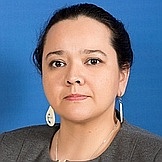Regional flags and emblems


PROFILE
Established 10 December 1930
Capital Anadyr
The Chukotka Autonomous Area is part of the Far Eastern Federal District
Area 721,500 sq km
Population 47 900 (2025)
Ethnic groups
(2020 national census, %)
Russian – 54,21
Chukchi – 28,25
Ukrainian – 3,24
Eskimo – 3,10
Even (Lamut) – 2,73
Chuvan – 1,58
Other – 6,89
Administrative divisions (2024)
Municipal districts – 3
City districts – 4
Rural towns – 3
Rural districts – 20
Geography and climate
The Chukotka Autonomous Area is Russia’s most northeastern territory. It occupies the Chukchi Peninsula and the neighboring area of continental Eurasia. Chukotka is washed by the East Siberian Sea, the Chukotka Sea and the Bering Sea and includes the Wrangel and Ratmanov islands, among others. About half of the territory lies north of the Arctic Circle. The larger part of the Chukotka Autonomous Area is located in the Eastern Hemisphere while the Chukchi Peninsula is in the Western Hemisphere.
The area’s main geographical features are the Oloy and Ush-Urekchen mountain ridges in the west, the Anyui Ridge and the Anadyr Plateau in the center, the Chukotka Upland in the east, with the Anadyr Lowland lying to the south of that, and the Koryak Mountains to the southeast. The lowlands are very marshy and include many lakes. Tundra occupies three-fourths of the entire area.
The Chukotka Autonomous Area borders on the following Russian entities: the Republic of Sakha (Yakutia), the Kamchatka Territory and the Magadan Region.
The territory has an extreme continental climate in the south and a subarctic and Arctic climate in the north. The average January temperature is –23.7°С and the average July temperature is +10.6°C. Average precipitation in January is 20 mm; mean precipitation in July is 40 mm.
The Chukotka Autonomous Area features the Ostrov Wrangel State Nature Reserve, among five others, 21 regional natural landmarks and Beringiya National Park.
Government
The legislative branch is the Chukotka Autonomous Area Duma, which is the permanent, representative and only legislative body in the area.
The Chukotka Autonomous Area Duma has 15 deputies, with six of them running in multi-seat constituencies and the other nine in the single electoral district in proportion to the number of votes cast for lists of candidates. The current Chukotka Autonomous Area Duma was elected in September 2021. Its term expires in September 2026.
The executive branch is the Government of the Chukotka Autonomous Area the supreme permanent executive authority headed by the Governor. There are also other executive bodies.
The Governor is the region’s highest-ranking official of the Chukotka Autonomous Area who heads the executive authority of the region and determines the structure of the executive bodies in the region, elected for five years by Russian citizens who permanently reside in the region.. The term of office of the current incumbent expires in September 2028.
Economy and natural resources
Industrial production accounts for over 50% of Chukotka’s regional GDP.
The mining sector is based on the proven reserves of gold, silver, ferrous and non-ferrous metals, coal, hydrocarbons, copper, touchstone, limestone and facing stone. Gold mining is the leading sector of the local economy, as the Chukotka Autonomous Area has about 10% of Russia’s proven gold reserves. Root gold accounts for 83% of all the reserves and alluvial gold about 17%. Currently, five mines, Kupol, Karalveyem, Valunistoye, Dvoinoye and Maiskoye, produce gold. Preparations are underway to start developing the Kekura, Klyon and Peschanka deposits. Major gold-mining companies include Chukotskaya Gorno-Geologicheskaya Kompaniya, Severnoye Zoloto, Zolotorudnaya Kompaniya Maiskoye, Rudnik Karalveyem and Rudnik Valunisty. Some 15 companies are involved in the seasonal production of alluvial gold.
The leading manufacturing industries are non-ferrous metallurgy, production of building materials, the energy sector and the timber and wood processing industry as well as food industry.
Electricity, heat and water are produced and distributed by a Rosenergoatom subsidiary, Bilibinskaya Nuclear Power Station, as well as Anadyrskaya Heat and Power Station and Chukotenergo Company. The Akademik Lomonosov floating heat and power station is operating in the area.
Agriculture accounts for less than 1% of the regional GDP. The key sectors are northern deer breeding, sea mammal hunting and poultry farming.
Culture and tourism
Due to its harsh climate and vast potential for development, Chukotka offers many opportunities, primarily to the enthusiasts of extreme and research tourism. Cruise ships are also used in the area. Cruise programmes include visits to unique natural, historical and cultural landmarks, such as Kitovaya Alleya (Whale Alley) on Ittigran Island, Lorinskiye thermal springs, ethnographic sites at capes Nunyamo and Dezhnyova and ethnic settlements.
A 10-metre-tall monument to St Nicholas the Wonderworker is an Anadyr landmark worth seeing. Next to it is Life-Giving Trinity Cathedral, Russia’s largest wooden church built on permafrost. It stands on piles lest its foundation begin to rot.
Those interested in the indigenous cultures will be attracted by the town of Uelen, Russia’s easternmost settlement where people first settled 2,000 years ago. Here they will become acquainted with the daily lives of the Chukchi and Eskimo and their traditional occupation, sea hunting, and visit a bone carving shop integrated with a museum to display a collection of genuine works of art made of walrus bone, leather, fur and whalebone.
Beringiya National Park on Wrangel Island, which at one time was the isthmus between the two continents, will attract tourists interested in nature and ethnic cultures. It keeps ice-bound carcasses of fleecy rhinos, bison and mammoth and was created to preserve the historical and cultural heritage, the unique hunting culture of Eskimo and Chukchi and biological diversity. Particularly popular among tourists are old Eskimo cultural landmarks that have survived in local villages.


